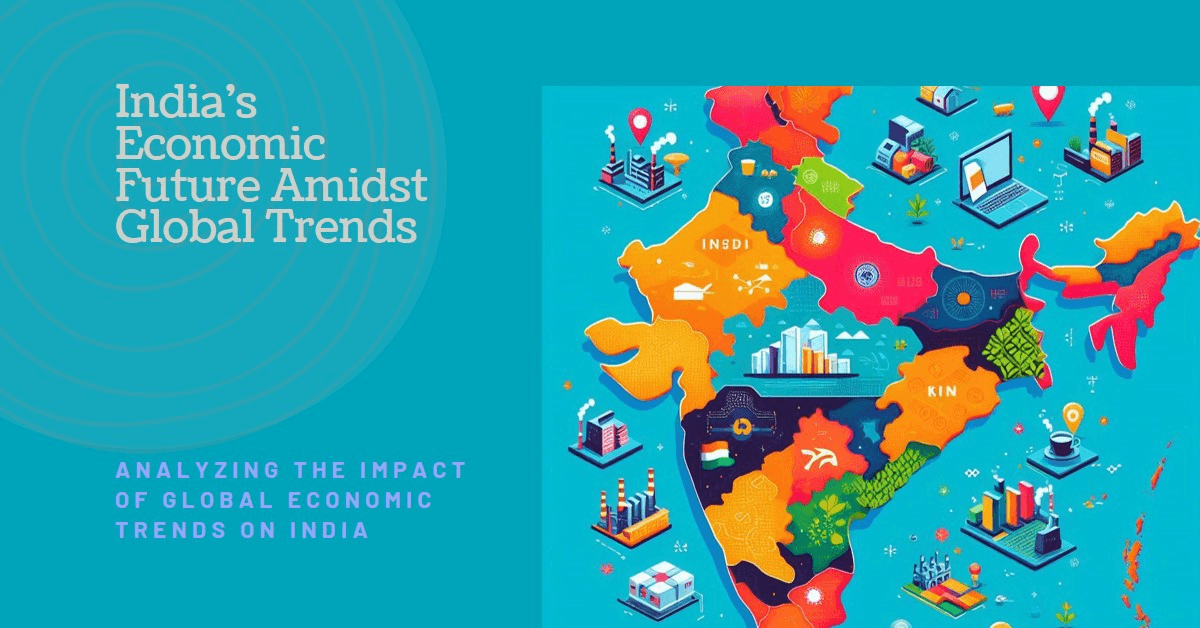
In today’s interconnected world, the global economy has become a key factor influencing national economies. As the world’s fifth-largest economy, India is deeply integrated into the global economic system. The impact of global economic trends on India has become increasingly significant, affecting its businesses, imports, exports, and GDP growth. This article examines how recent developments in global markets—such as crude oil prices, the state of the U.S. economy, and China’s economic slowdown—are shaping India’s economic landscape.
The Importance of Global Economic Trends for India
India’s economic success is intertwined with global markets due to its large trade portfolio, dependence on energy imports, and its status as an attractive destination for foreign investments. Fluctuations in key global economic indicators can create ripples across sectors, affecting India’s businesses, consumers, and policymakers.
India has witnessed substantial economic growth over the past decade, and it aspires to become a $5 trillion economy. However, achieving this ambitious target depends not only on domestic policies but also on how the global economic environment evolves. This interdependence makes it crucial for Indian businesses and policymakers to stay aware of global economic developments and to respond accordingly.
Crude Oil Prices and Their Impact on India
Crude oil is a significant input for India, as the country is one of the largest consumers of oil in the world. India imports over 80% of its crude oil needs, making it highly vulnerable to fluctuations in global oil prices. Changes in crude oil prices can significantly impact India’s economy by affecting inflation, trade balance, and fiscal deficit.
Impact on Businesses
Indian businesses, particularly those in the transportation, manufacturing, and chemical industries, are sensitive to changes in oil prices. When crude oil prices rise, businesses face increased operational costs due to higher fuel and energy expenses. This, in turn, puts pressure on profit margins, leading companies to either absorb the cost or pass it on to consumers. On the other hand, when oil prices fall, businesses benefit from lower input costs, improving profitability and competitiveness.
Additionally, industries such as aviation, logistics, and heavy manufacturing experience a direct impact from changes in fuel prices. The aviation sector, for example, has seen ticket prices fluctuate due to changing oil costs. Businesses involved in logistics and transportation also see an increase in freight costs when oil prices rise, affecting their overall profitability.
Impact on Imports and Exports
Crude oil price changes also have a direct impact on India’s import bill. Higher oil prices increase India’s import costs, widening the trade deficit. Conversely, lower oil prices reduce the import bill, improving the trade balance. The trade deficit influences the value of the Indian rupee and foreign exchange reserves, creating challenges for policymakers who seek to maintain currency stability.
India’s oil-dependent industries, particularly petrochemicals, also see shifts in export competitiveness due to changes in oil prices. High oil prices can raise production costs, reducing the competitiveness of Indian exports in the global market.
Impact on GDP Growth
The relationship between oil prices and GDP growth is complex. Rising oil prices can slow GDP growth due to inflationary pressures and higher input costs for businesses. As fuel prices rise, consumer purchasing power declines, leading to reduced consumption and lower economic growth. Alternatively, falling oil prices can stimulate growth by lowering inflation and improving business profitability, leading to increased investment and higher consumer spending.
U.S. Economy and Its Influence on India
As the largest economy in the world, the U.S. has a significant influence on global trade, finance, and investments. India’s trade relations with the U.S. are substantial, with the U.S. being one of the largest markets for Indian exports, particularly in sectors like IT services, pharmaceuticals, textiles, and machinery. Therefore, the health of the U.S. economy has far-reaching consequences for India.
Impact on Indian Exports
A strong U.S. economy drives demand for Indian goods and services. For instance, the Indian IT services sector, which provides services to many U.S. businesses, benefits from economic growth in the U.S. A robust U.S. economy also stimulates demand for Indian pharmaceutical products, textiles, and gems. Conversely, when the U.S. economy slows down or faces a recession, Indian exporters experience reduced demand for their goods and services, potentially leading to job losses in export-dependent sectors.
Impact on Foreign Direct Investment (FDI)
The U.S. is a major source of FDI into India, contributing to the development of various sectors like technology, manufacturing, and services. Economic stability in the U.S. is crucial for maintaining strong FDI inflows into India. When the U.S. faces economic challenges, American companies tend to scale back investments abroad, which can reduce FDI inflows into India. A slowdown in FDI can affect job creation, infrastructure development, and technology transfer, potentially slowing India’s economic growth.
Impact on the Indian Rupee
The value of the Indian rupee is often influenced by movements in the U.S. dollar. When the U.S. economy strengthens and the U.S. Federal Reserve raises interest rates, global investors tend to flock to dollar-denominated assets, leading to capital outflows from emerging markets like India. This can cause the Indian rupee to depreciate against the dollar, making imports more expensive and adding inflationary pressures to the economy.
China’s Economic Slowdown and Its Impact on India
China’s role as a major global economic player means that its economic performance has far-reaching implications. Over the past few years, China has experienced slower economic growth, driven by factors such as trade tensions with the U.S., structural issues in its economy, and the effects of the COVID-19 pandemic. China’s slowdown has had both direct and indirect effects on India’s economy.
Impact on Indian Exports and Imports
China is India’s largest trading partner, and any slowdown in China’s economy can affect India’s export growth. Indian exporters, especially those in the raw material and chemical industries, have faced reduced demand from Chinese companies. This decline in exports can hurt India’s industrial output and employment.
On the other hand, China’s slowdown has presented opportunities for Indian manufacturers. With multinational companies diversifying their supply chains away from China, India has become an attractive destination for foreign companies looking to reduce their reliance on Chinese manufacturing. This trend, known as the “China Plus One” strategy, has led to increased investment in India’s manufacturing sector.
India also imports a significant portion of its capital goods, electronic components, and machinery from China. A slowdown in China’s economy could disrupt supply chains and lead to increased prices for Indian manufacturers, creating challenges for industries that depend on Chinese inputs.
Impact on Global Commodity Prices
China is a major consumer of commodities such as metals, minerals, and energy products. A slowdown in China’s economy reduces global demand for these commodities, leading to a decline in their prices. For India, this could result in lower input costs for industries that rely on imported commodities, improving business profitability. However, declining global commodity prices can also hurt Indian exporters in sectors such as mining and metal production.
Impact on Regional Geopolitics
China’s economic slowdown has also had geopolitical implications for India. As China’s economic clout diminishes, India has an opportunity to enhance its influence in the region. India’s growing role in global supply chains and its efforts to strengthen trade ties with countries such as Japan, Australia, and Southeast Asian nations have gained momentum. These efforts align with India’s strategic interest in reducing its reliance on China and asserting itself as a global economic player.
Other Global Economic Trends Impacting India
Apart from the major trends discussed above, several other global developments are also shaping India’s economic trajectory.
Global Inflation
Inflationary pressures around the world, driven by supply chain disruptions, rising commodity prices, and loose monetary policies, are affecting India’s inflation dynamics. Global inflation can lead to higher import costs for India, exacerbating domestic inflation and affecting consumer demand. Moreover, central banks in major economies, such as the U.S. Federal Reserve and the European Central Bank, are tightening monetary policies in response to inflation, which can lead to capital outflows from emerging markets like India.
Global Trade Tensions
Trade tensions, particularly between the U.S. and China, have created uncertainties in the global trade environment. India has both gained and lost from these tensions. On the one hand, India has benefited from companies looking to diversify their supply chains away from China. On the other hand, the disruption of global trade has created challenges for Indian exporters and importers, particularly in sectors like electronics, textiles, and automotive.
Shifts in Global Supply Chains
The COVID-19 pandemic has accelerated shifts in global supply chains, with many countries looking to reduce their dependence on China. India has emerged as a key player in this shift, with initiatives such as “Make in India” and the Production Linked Incentive (PLI) scheme attracting investment into the manufacturing sector. India’s growing role in global supply chains presents opportunities for economic growth and job creation, particularly in industries such as electronics, pharmaceuticals, and automobiles.
Conclusion
The impact of global economic trends on India is profound, influencing various aspects of the economy, including businesses, imports, exports, and overall GDP growth. Developments such as changes in crude oil prices, the U.S. economic situation, and China’s economic slowdown create both challenges and opportunities for India. As a key player in the global economy, India must navigate these trends carefully, ensuring that its domestic policies are aligned with global realities.
India’s ability to adapt to these trends will determine its success in maintaining robust economic growth and achieving its long-term objectives. The country’s policymakers, businesses, and investors must stay vigilant, leveraging global opportunities while mitigating risks. By doing so, India can continue to grow as a major global economic power.
For more insights into India’s economic landscape and how businesses can adapt, you can explore further on India’s Economic Reforms or learn about the U.S.-India Business Council, which fosters trade and investment between the two countries.
Internal Links:
External Links:









Your blog has become an indispensable resource for me. I’m always excited to see what new insights you have to offer. Thank you for consistently delivering top-notch content!